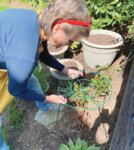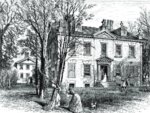Shovel after shovel, the spade cuts into the dark, moist, nutrient-rich earth. The gardener kneels and gently places the plant into its new home.
This item is available in full to subscribers.
We have recently launched a new and improved website. To continue reading, you will need to either log into your subscriber account, or purchase a new subscription.
If you are a digital subscriber with an active subscription, then you already have an account here. Just reset your password if you've not yet logged in to your account on this new site.
If you are a current print subscriber, you can set up a free website account by clicking here.
Otherwise, click here to view your options for subscribing.
Please log in to continue |



Shovel after shovel, the spade cuts into the dark, moist, nutrient-rich earth. Reaching the right depth, the gardener kneels and gently places the plant into its new home, loosely hand-smoothing the displaced dirt around it.
A taste of water, a housewarming gift to ease the plant's transition, completes the task and brings the gardener a quiet sense of satisfaction and fulfillment.
Potted plants on window sills, window boxes outside rowhomes, beds of luxuriant rose bushes in backyards, and immaculately manicured public grounds — gardening, in all its forms, is Philadelphia. It's why the City of Brotherly Love is also America's Garden Capital and the cradle of American horticulture.
"If I look at my neighbors, most of them do some form of gardening," says Andrew Bunting, vice president of horticulture at the Pennsylvania Horticultural Society, founded in Philadelphia in 1827. "They feel that their garden, or their yard, is important to their property and may be to who they are. They really see the value in gardening."
Nicole Juday, author of the recently published book, “Private Gardens of Philadelphia,” which she co-produced with photographer Rob Cardillo, describes it as "a culture of horticulture."
"There are such a large number of experienced and talented gardeners here that communities literally sprout up amongst us," Juday says.
It's a value rooted in the city's Quaker history that has grown stronger over the centuries. Without venturing too deeply into the historical weeds, David Contosta says, William Penn and the Quakers dismissed the fine arts as frivolous and a waste of time. Penn believed Quakers should find their recreation and express their creativity through nature.
Creativity through nature
"Quakers were allowed to take out their artistic impulses on gardening and arboretum," says Contosta, a professor of history at Chestnut Hill College and author of four books about the Wissahickon Valley. They believed that "gardening should serve as the recreation of your mind."
And so the seed was planted. Gardening became imprinted on the city's DNA.
Fast-forward to the late 1800s, and Philadelphia has evolved into the country's horticultural hothouse. Wealthy Philadelphians buy large swaths of land to build estates and formal gardens. Many women, who lived with societal expectations that kept them out of the workplace, formed garden clubs.
"In fact, The Garden Club of America was founded in Philadelphia," Contosta says.
Many of those gardens still grace the landscape in and around Philadelphia. In fact, there are 40 public gardens within 30 minutes of the city. But all the gardens — public and private, large and small — that helped establish Philadelphia as the nation's garden center may have withered and died if not for the oldest rule of real estate: location, location, location. Philadelphia's location is prime plant terra firma.
It starts with the region's topography, Contosta says. Center City is part of the flat coastal plain. Somewhere around Germantown, through Mt. Airy, and into Chestnut Hill, the landscape transitions into a piedmont plateau leading to the foothills of the Appalachian Mountains.
"There are no great peaks in the hills, and the valleys are fairly gentle," Contosta says. "What it does is modulate the light and shadows so the plants have different exposures on different sides."
'Not too hot, not too cold'
Philadelphia is sometimes referred to as the nation's northernmost Southern city and the southernmost Northern city. That is because it is positioned where two temperature zones intersect into what could be called Goldilocks territory. It's not too hot and not too cold, but just right. The region is frost-free seven months of the year, allowing for a longer growing season.
"We are kind of in a sweet spot for growing the northern, more temperate plants as well as many of the more southern type plants like crepe myrtles and camellia that are more iconically southern," Bunting says.
If the United States Department of Agriculture's recently released plant hardiness map holds true, it should stay that way for the foreseeable future. In 2012, the USDA classified the Philadelphia region as Zone 7b, which means there is a minimum average temperature difference of 5 to 10 degrees. Eleven years later, that hasn't changed — for now.
As for the actual soil around Philadelphia, Contosta says it goes from being "kind of acidic" in Mt. Airy and Chestnut Hill to more alkaline in parts of Montgomery County because the ground is underlined with limestone.
"I think that tells you about the variety here which can support a lot of different plants," he says.
A rose is a rose
Among the plants supported by the topography, climate and soil are the centuries-old heritage roses growing in the garden at the historic Wyck House in Germantown. These roses are a significant draw for visitors. In late May, when the roses bloom, Wyck holds its Celebration of the Roses, during which it will host 40% to 60% of its annual visitors. People come from all around to stroll the garden path, admire the roses, and breathe in their delicate, perfumy scent.
"The roses are certainly a draw," says Kim Staub, executive director of the Wyck Association. "People are interested in having Wyck's historic varieties of roses. It's a connection to nature, a connection to the land. There are so many connections between past and present."
The remaining 40% to 60% of guests come to see the 283-year-old house, garden, and grounds during the rest of the year. Staub issues and stamps garden passports for people who want to keep a record of the local gardens they have seen. While she enjoys introducing new guests to Wyck, she gets the most pleasure from seeing the familiar faces of neighbors and their children who come to walk the grounds and play. There are even regular visitors who eat lunch in the garden almost every day.
"I think what is the most rewarding is when you see your neighbors coming again and again to experience the garden and see what is blooming today," Staub says. "And they will talk about it so you know that they are paying attention and they are really enjoying the green space. We want people to know that Wyck is for everyone. If the gates are open, come on in."
More than three centuries after Penn directed his Quaker followers to find enjoyment and recreation in nature, Philadelphians continue to follow his advice.
Today, Philadelphia boasts more than 400 community vegetable gardens throughout the city and countless home gardens, nurseries, seed growers, plant sellers, and plant distributors.
Spiritual uplift
Contosta says working in a garden, digging weeds, planting flowers, and watching things grow is therapeutic.
It removes us from our work-a-day lives and puts us in touch with nature. It is, he says, a psychological, emotional, and maybe just a bit of a religious experience, direct from the 1600s. Staub agrees.
"I think it has to be a part of who we are, to want to experience that joy that nature can bring," Staub says. "And in that sense, we all have, maybe deep down, a little bit of Quaker in us. That love of nature, of horticulture, is just passed down."
Somewhere, Penn is smiling.